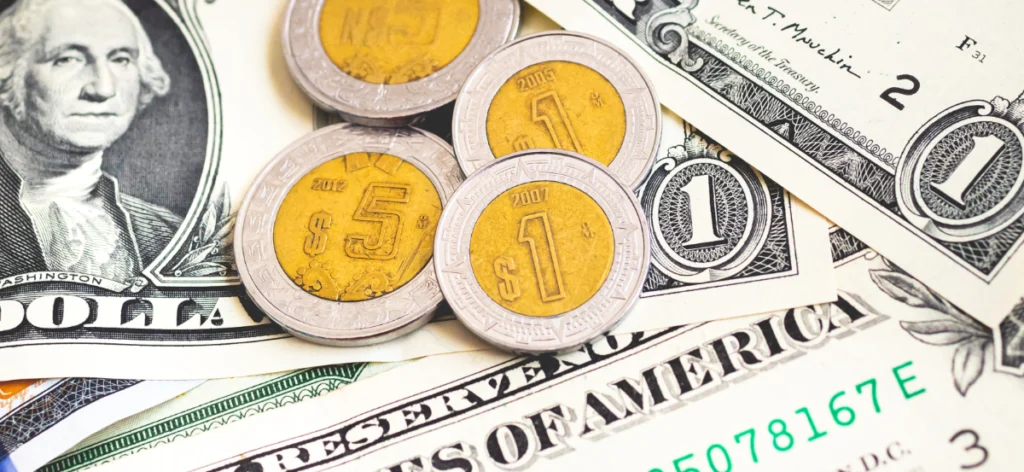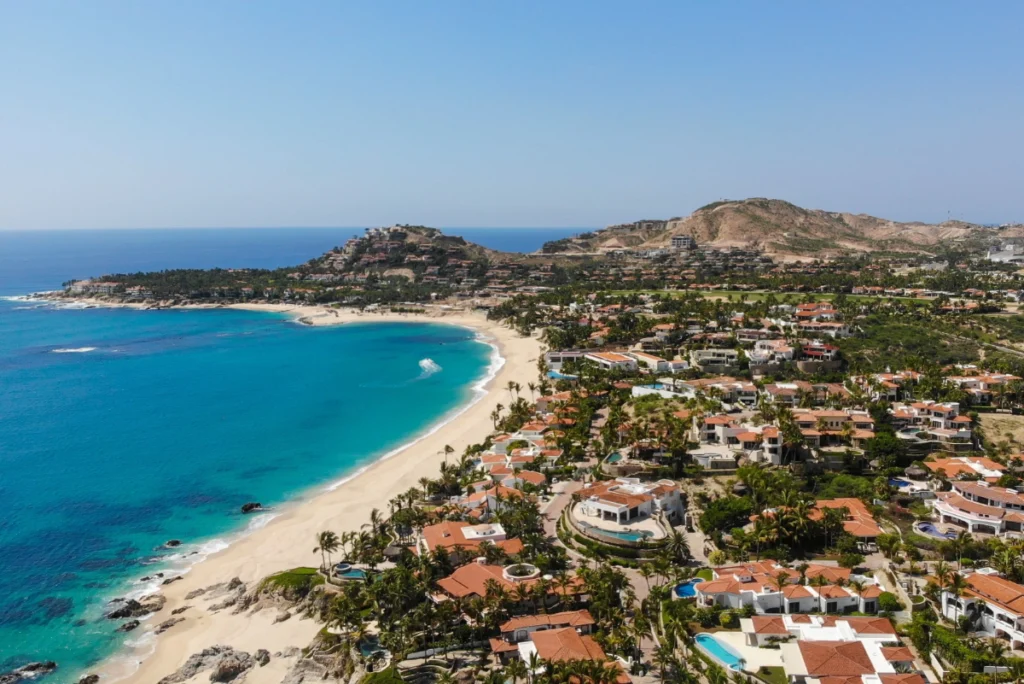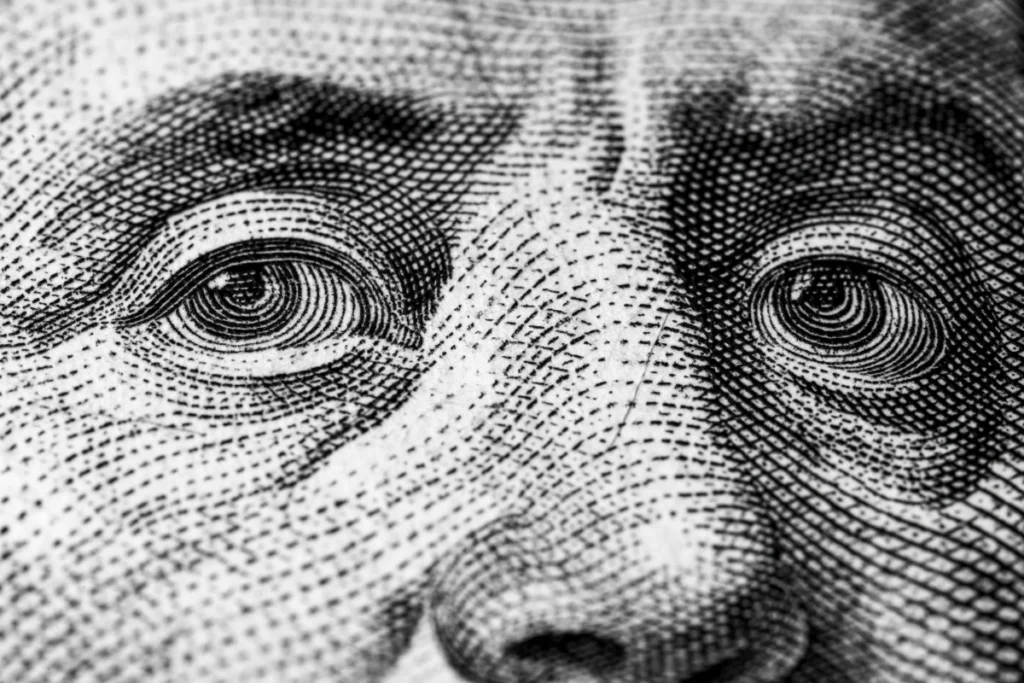The performance of the Mexican peso against the U.S. dollar has shown significant fluctuations over the past decade. Various economic, political, and geopolitical factors influenced these shifts. Understanding these currency dynamics is crucial for buyers and sellers in Baja California Sur’s real estate market. Real estate transactions in this state are often denominated in dollars, even though Mexico’s official currency is the peso. Expert local advisors can deploy diverse currency risk and opportunity strategies to navigate this situation.
In a recent conversation with Ian Gengos, Berkshire Hathaway HomeServices Baja Real Estate broker, we explored how these fluctuations impact property transactions, capital gains tax calculations, and overall investment strategies.

Recent Peso-Dollar Exchange Rate History
- 2014-2015. The peso began a depreciation period, influenced by falling oil prices and concerns about Mexico’s economic growth. In 2015, the exchange rate averaged around 15.90 pesos per dollar.
- 2016-2017. The peso experienced volatility due to political uncertainties. These included the U.S. presidential election and trade negotiations around the USMCA (formerly NAFTA). The average exchange rate rose to approximately 18.69 pesos per dollar in 2016, reflecting a depreciation trend.
- 2018-2019. The peso stabilized somewhat, averaging 19.22 pesos per dollar in 2018. However, it fluctuated between 18 and 20 pesos per U.S. dollar. Trade tensions and U.S. economic policies influenced this volatility.
- 2020. The COVID-19 pandemic caused significant market disruptions. Which led to a peak exchange rate of about 24.50 pesos per dollar in April 2020. Investors sought safe-haven currencies. By the end of the year, it had settled around 19.90 pesos per dollar.
- 2021-2022. The peso recovered, averaging around 20 pesos per dollar in 2022. Factors such as rising interest rates in Mexico and a rebound in U.S. economic activity supported the peso’s strength.
- 2023. The peso reached a low of approximately 16.60 pesos per dollar by mid-year. It closed the year at about 17 pesos per dollar, showing resilience amid global economic challenges.
- 2024. The peso began a downward trajectory against the dollar in June. It has been a challenging year for the peso, marked by significant depreciation and volatility influenced by domestic and international political and economic conditions.
Mexico’s Official Currency Is Highly Connected With the Global Market
It is worth noting that the peso is a highly traded currency. Its average daily trading volume was approximately $114.2 billion in 2022. This makes it the 16th most actively traded currency globally and the third most traded among emerging market currencies. The Chinese renminbi and Indian rupee come first. Its interconnectedness with the global market makes the Mexican peso sensitive to currency risk and market dynamics worldwide.
Understanding Currency Risk: Key Factors Impacting the Peso-Dollar Exchange Rate
Several key factors influence the peso-dollar exchange rate, creating potential currency risk that impacts real estate transactions and investments in Baja California Sur. Economic conditions in Mexico and the U.S., interest rate differentials, political stability, inflation rates, and commodity prices play crucial roles. Additionally, market speculation can drive short-term volatility. Which makes it essential for real estate buyers and sellers to stay informed about these dynamics.
Economic Conditions
The overall economic health of both Mexico and the United States plays a significant role in determining the exchange rate. A strong U.S. economy typically strengthens the dollar. And robust economic performance in Mexico can lead to an appreciation of the peso. Recent trends show that Mexico has benefited from U.S. growth due to nearshoring. This phenomenon is where U.S. companies relocate manufacturing closer to home. It enhances Mexico’s economic prospects.
Interest Rates
Interest rates are crucial in influencing currency values. The Bank of Mexico has maintained higher interest rates than the U.S. Federal Reserve, with rates reaching up to 11% in Mexico versus 5.5% in the U.S. This interest rate differential attracts yield-seeking investors to Mexican assets, thereby supporting the peso’s value against the dollar.
Political Stability
Political conditions in both countries also affect currency strength and currency risk. Instability can lead to currency depreciation as investors seek safer investments elsewhere. For instance, recent controversies regarding judicial reforms in Mexico have raised concerns. They may have recently impacted the peso’s strength against the dollar.
Inflation Rates
Inflation differentials between the two countries can influence exchange rates as well. If inflation is higher in the U.S. than in Mexico, this can lead to a stronger peso. Purchasing power increases relative to the dollar.
Commodity Prices
As a major oil exporter, fluctuations in oil prices significantly impact the Mexican economy and, thus, the peso’s value. Higher oil prices typically bolster Mexico’s economic strength and support its currency.
Market Speculation
Investor speculation can cause volatility in exchange rates, contributing to currency risk. Traders often buy or sell currencies based on anticipated future movements. And this can lead to rapid changes in exchange rates based on market sentiment rather than fundamental economic indicators.

Navigating Currency Fluctuations and Currency Risks in Baja California Sur’s Real Estate Market
We have surveyed the recent exchange rate history between the dollar and the peso. It is interesting to note the implications of this dual currency system in real estate in Baja California Sur, a coveted market among global investors. Real estate transactions must be recorded in both dollars and pesos at the time of closing. This requirement means that fluctuations in the exchange rate can impact the final value of the transaction.
Selling Property: Understanding Capital Gains and Currency Fluctuations
Understanding the impact of currency fluctuations is essential when selling property in Baja California Sur. It is particularly pertinent when calculating capital gains tax. Many property transactions are conducted in dollars. But the Mexican government calculates capital gains based on the property’s value in pesos, both at the time of acquisition and at the time of sale.
Ian Gengos highlights a crucial aspect of this process. “Even if you buy and sell a property using U.S. dollars, the Mexican government considers the transaction in pesos. Determining the exchange rate at the time of purchase and sale is important. When selling, the authorities calculate your capital gains based on the acquisition price in pesos.”
The Mechanics of Capital Gains and Currency Exchange
Here’s how the process works in practice:
- Initial Purchase and Peso Valuation. When you buy a property in Baja California Sur, the purchase price is converted into pesos at the exchange rate on the day of the transaction. For example, if you purchase a 1 million USD property at an exchange rate of 15 pesos to the dollar, the authorities will record the purchase as 15 million pesos.
- Sale and New Peso Value. Fast forward to the time of selling. If you sell the property for the same 1 million USD, but the exchange rate has since shifted to 20 pesos to the dollar, the property’s sale price is now valued at 20 million pesos in the eyes of the Mexican government. Even though the dollar value of the property hasn’t changed, the peso value has appreciated by 5 million pesos.
- Taxation on the Peso Gain. Capital gains tax is then assessed on the difference between the original peso value (15 million pesos) and the new peso value (20 million pesos) despite no dollar-based profit. The seller must pay taxes on this 5-million-peso “profit,” which is purely the result of currency fluctuation and not an increase in the property’s value in real terms.
Managing Currency Risk in Real Estate Sales
Currency fluctuations can significantly impact the net proceeds of a property sale. To minimize exposure to this risk, sellers should consider the following strategies:
- Timing the Sale. Timing the sale to coincide with favorable exchange rates can make a substantial difference. Selling when the peso is more robust against the dollar can reduce the taxable “gain” in pesos, resulting in a lower capital gains tax.
- Property Valuation and Deductions. Sellers should work with a qualified Mexican accountant or real estate lawyer to ensure that all allowable deductions—such as renovation costs, legal fees, and improvements to the property—are adequately documented. These deductions can offset the capital gains tax and help mitigate the impact of unfavorable currency movements.
- Consider Peso-Denominated Transactions. While most international buyers and sellers prefer conducting real estate transactions in U.S. dollars, some sellers might find it advantageous to price and sell the property in pesos, especially if they expect to remain in Mexico and pay expenses in pesos. This approach can reduce exposure to currency fluctuations.
Professional Guidance Is Key
Given the complexities involved in selling property in Baja California Sur, working with experienced real estate agents, tax professionals, and legal advisors who understand local regulations and currency exchange nuances is essential. Sellers can significantly reduce their tax burden and maximize their profits by carefully planning the sale and considering the timing of currency exchange.
Ian notes, “Having a professional team on your side can make the difference between a smooth, profitable sale and an unexpected tax hit. Real estate in Baja California Sur offers great opportunities, but navigating the financial side of things requires local expertise.” By being proactive, sellers can take full advantage of the region’s real estate market while managing the risks associated with currency fluctuations.

Opportunities for Buyers: Does a Strong Dollar Offer an Edge Against Currency Risk?
For buyers, the current market conditions in Baja California Sur offer an opportunity to gain an edge thanks to a strong U.S. dollar. A strong dollar enables buyers to register a higher peso valuation for their property. This condition potentially reduces future capital gains tax liability, as the peso value at the time of acquisition will be higher, possibly lowering the taxable “gain” when the property sells.
However, since real estate prices in Baja California Sur are generally in dollars, fluctuations in the exchange rate do not significantly affect the buying decisions of U.S. citizens. On the other hand, a stronger peso tends to attract interest from Mexican buyers looking to invest in the Baja California Sur market.
Market Inventory and Timing Are Vital Factors Buyers Must Consider
Beyond the favorable exchange rate, 2024 presents an attractive opportunity for U.S. buyers in Baja California Sur. Inventory levels have increased due to geopolitical factors, uncertainty surrounding upcoming election cycles, and the cyclical nature of the real estate market. These elements have contributed to buyer hesitancy, creating more availability in the market. With more options, buyers can be more selective, often negotiating better deals or securing premium properties that may not have been available under tighter market conditions.
Ian also notes that this influx of inventory means buyers may have less competition for highly desirable properties, which can further drive down prices. “More homes are on the market now than we’ve seen in recent years. It’s a unique window where a strong dollar and increased inventory align—buyers who take action now can benefit.”
Evaluating Currency Risk and Key Investment Factors in Baja California Sur’s Real Estate Market
While a strong U.S. dollar and increased inventory create favorable conditions, buyers must evaluate other factors that could impact their investment. Market trends, geopolitical risks, and the economic outlook in Mexico and the U.S. all play roles in real estate value. Additionally, local regulations, the potential for new development projects, and the long-term vision for Baja California Sur’s growth are factors worth considering.
For instance, areas like Los Cabos and Todos Santos continue to see strong interest from international buyers, driven by the region’s appeal as a lifestyle and investment destination. New infrastructure developments, such as expanded airports and improved highways, will likely increase property values over time. Buyers looking for long-term investments should weigh these growth prospects against short-term market fluctuations.
The Impact of Currency Fluctuations on Pre-Construction Investments
Pre-construction real estate in Baja California Sur is susceptible to fluctuations in currency exchange rates. As shown in the historical overview above, the peso’s value against the dollar has significantly changed in recent years. These currency shifts can have significant implications for buyers who entered pre-construction contracts during periods of volatility.
Developers, whose costs are often calculated based on a specific exchange rate, may encounter unexpected challenges if the dollar weakens. When the peso appreciates, the developer’s income decreases, as the pre-construction units they are selling are most likely priced in dollars. The cost of materials or labor in pesos remains the same, potentially leading to price adjustments or construction delays. Some developers may attempt to pass these increased costs on to buyers, creating financial uncertainty, even for those who have already signed contracts.
To mitigate these currency risks, Ian stresses the importance of selecting a well-capitalized developer who can absorb potential currency fluctuations. “A smart developer will pre-purchase materials when the exchange rate is favorable and stockpile them to guard against rising costs,” he notes.
Buyers should carefully evaluate the developer’s financial stability and ensure they have a track record of managing projects through various economic climates. Inquiring about how a developer handles currency risk and whether they have contingency plans can also provide peace of mind to investors entering pre-construction deals.
Tips for Choosing a Developer in Baja California Sur
Choosing the right developer is critical for investing in pre-construction real estate in Baja California Sur. Ian’s insights underscore three essential factors that buyers should evaluate:
- Permitting. It is vital to ensure the developer has secured all necessary permits, including those related to water usage, environmental impact, and construction approvals. A developer with the proper permits will be better equipped to avoid legal and regulatory hurdles that could delay the project.
- Track Record. Assessing a developer’s previous projects provides valuable insights. It would be a positive sign if they had successfully delivered projects in Baja California Sur. Buyers should also consider the developer’s design philosophy. In Baja California Sur, many newer builders incorporate contemporary Mexican architecture, which may appeal to those seeking modern, innovative designs. Ensuring that the developer’s aesthetic aligns with the buyer’s vision for the property is crucial.
- Capitalization. Financially stable developers are better positioned to manage unforeseen economic changes, such as currency fluctuations or rising material costs. Ian advises buyers to choose developers who are not solely reliant on pre-sales to fund the construction. Well-capitalized developers are more likely to deliver projects on time and avoid financial pitfalls that could affect the quality or completion of the development.

Sancta Residences in La Paz: A Model of Financial Stability
Sancta Residences in La Paz is a prime example of a well-capitalized and expertly managed pre-construction project. This project is driven by a Mexican-based investment fund partnered with local real estate professionals Berkshire Hathaway HomeServices Baja Real Estate to market and sell the development.
What sets Sancta apart from many other projects in the region is its financial foundation. The project is fully capitalized, meaning it does not rely on the pre-sale of units to fund construction. This economic stability offers significant peace of mind to potential buyers, shielding them from currency risk.
Ian highlights how this approach to capitalization benefits everyone involved. “It’s always ideal for a developer to pre-sell units and gain some momentum, but the key with Sancta is that, regardless of sales pace, the project will be built. Buyers can rest assured that fluctuations in concrete prices or currency devaluation won’t affect the development schedule or quality of construction because the costs have already been managed ahead of time.”
This level of financial security is crucial in Baja California Sur, where construction costs can vary dramatically due to external factors such as currency exchange rates or global economic conditions. At Sancta Residences, the developer has already factored unexpected cost increases into the project’s budget. This planning allows the development to move forward without delays or financial strain, ensuring buyers get the high-quality product they were promised. It protects buyers.
Sancta Residences represents a prime opportunity for those considering a pre-construction investment to invest confidently. The project’s robust financial backing, focusing on quality construction and thoughtful design, makes it an attractive option for buyers looking for security in an uncertain economic landscape.
Maximizing Rental Income: The Role of Currency Risk and Exchange in Baja California Sur
For property owners in Baja California Sur, particularly those renting out vacation homes or investment properties, understanding currency risk and fluctuations is essential for maximizing rental income. Given that many tourists and seasonal renters come from the U.S. and Canada, rental agreements are frequently established in dollars. The dual-currency system can benefit or disadvantage property owners, depending on the prevailing exchange rates.
Ian explains, “Most rental income for vacation properties is earned in dollars because most renters are North Americans. This can be beneficial when converting to pesos for local expenses or paying taxes.”
When the U.S. dollar strengthens against the peso, property owners who collect rent in dollars can enjoy a higher exchange rate when converting rental income into pesos. This advantage is beneficial for covering property management fees and maintenance costs and paying utilities. These are typically billed in pesos.
However, property owners must also consider the tax implications of rental income. As with property sales, the authorities record rental income in pesos when filing taxes in Mexico. Fluctuations in the exchange rate may result in higher taxable amounts even if the rental income remains consistent in U.S. dollars.
Ian advises property owners to regularly monitor exchange rates and consider converting their earnings at strategic points throughout the year.
They can thus mitigate potential tax liabilities and optimize income. This approach helps ensure rental income maximizes purchasing power locally and complies with Mexican tax laws.
Tips for Managing Rental Income in Baja California Sur
Here are a few strategies for property owners to maximize their rental income while minimizing the currency risks associated with currency fluctuations:
- Maintain a Dual-Currency Approach. Open peso and U.S. dollar accounts at a local Mexican bank. This flexibility allows flexibility in converting rental income and taking advantage of favorable exchange rates.
- Negotiate Long-Term Contracts in Dollars. If your renters are from the U.S. or Canada, negotiating contracts in U.S. dollars can protect you from short-term currency fluctuations. This can help you maintain a stable income.
- Monitor the Exchange Rate for Expenses. Convert rental income to pesos when the exchange rate is favorable. Thus ensuring your local expenses, like maintenance and utilities, are more cost-effective.
Conclusion: Understanding Currency Dynamics in Baja California Sur Real Estate
The fluctuating exchange rate between the peso and the dollar plays a crucial role in the real estate market of Baja California Sur. Buyers and sellers alike must navigate the complexities of currency dynamics. These fluctuations can significantly impact property values, capital gains tax calculations, and overall investment strategies. Understanding the economic, political, and geopolitical factors influencing the peso’s performance is essential. Thus, one can make informed decisions about Baja California Sur real estate currency dynamics.
By leveraging expert guidance and implementing effective currency risk management strategies, Baja California Sur real estate market participants can maximize their opportunities and minimize potential risks. Ultimately, this understanding of currency dynamics in Baja California Sur real estate leads to successful transactions in this vibrant and sought-after region.
